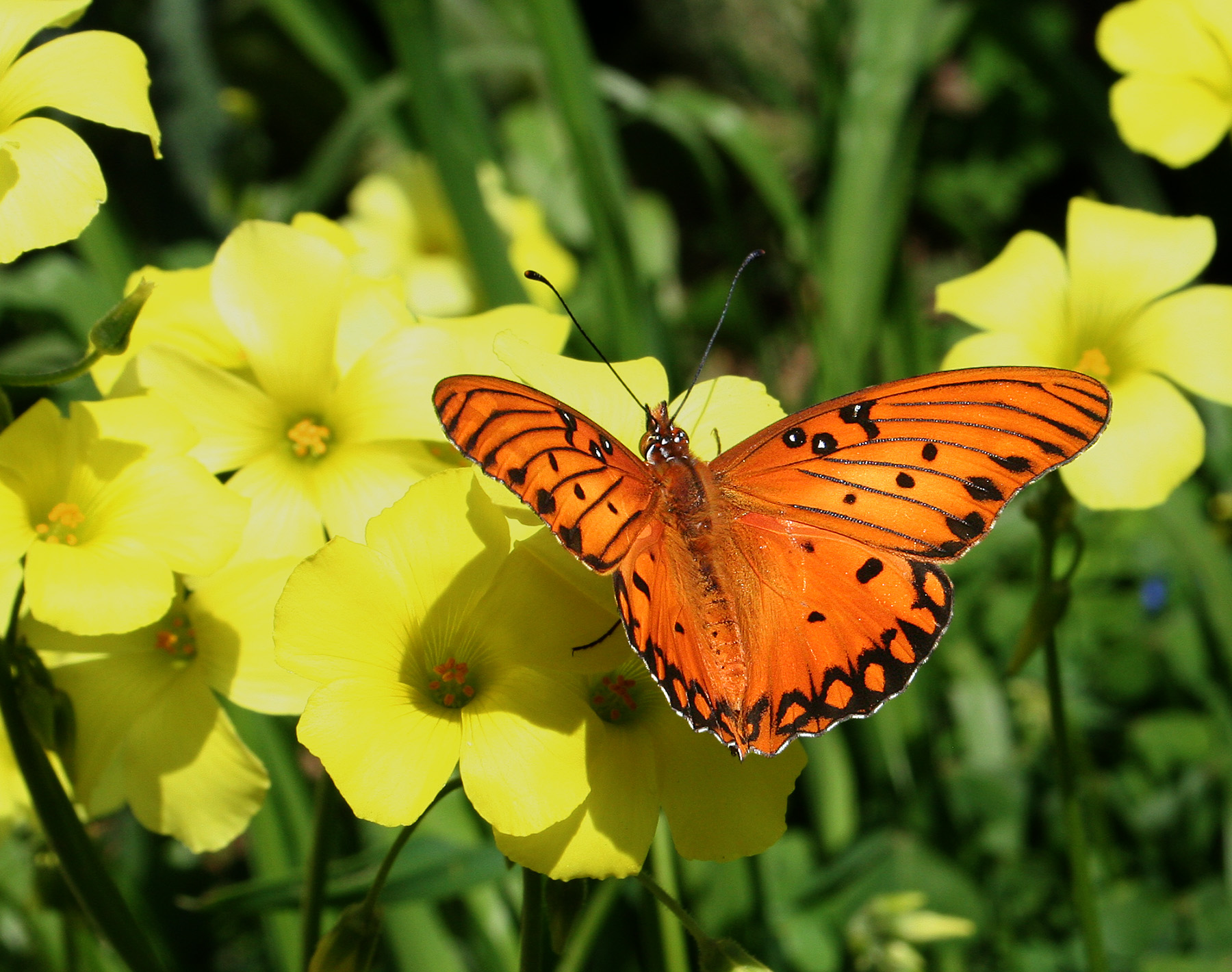- Gulf Fritillary
Taxobox
name = Gulf Fritillary
status = LC
status_system = iucn3.1
status_ref =

image_width = 250px
regnum =Animal ia
phylum =Arthropod a
classis =Insect a
ordo =Lepidoptera
unranked_familia =Rhopalocera
familia =Nymphalidae
subfamilia =Heliconiinae
tribus =Heliconiini
subtribus =Heliconiiti
genus = "Agraulis "
species = "A. vanillae"
binomial = "Agraulis vanillae"
binomial_authority = (Linnaeus,1758 )The Gulf Fritillary, "Agraulis vanillae", a striking, bright orange
butterfly of the familyNymphalidae , subfamilyHeliconiinae . These were formerly classified in a separate family, the Heliconiidae or longwing butterflies, and like other longwings this species does have long, rather narrow wings in comparison with other butterflies. It is not closely related to the true fritillaries. It is a medium to large butterfly, with a wingspan of from 6 to nowrap|9.5 cm. Its underwings are buff, with large silvery spots. It takes its name from the fact that migrating flights of the butterflies are sometimes seen over theGulf of Mexico .The Gulf Fritillary is commonly seen in parks and gardens, as well as in open country. Its range extends from
Argentina throughCentral America ,Mexico , and theWest Indies to the southernUnited States , as far north as theSan Francisco Bay Area on the west coast. It is occasionally found further north in the US.Larva
The
larva orcaterpillar of the gulf fritillary grows to approximately nowrap|4 cm in length and is bright orange in color and covered in rows of black spines on its head and back. The spines are soft to the touch and do not sting. However, the larva are poisonous if eaten, as the bright coloration advertises. The larva feed exclusively on various species ofpassionflower such asmaypop ("Passiflora incarnata"), theyellow passionflower ("P. lutea") andrunning pop ("P. foetida").Their toxic flesh provides gulf fritillary caterpillars with excellent protection from predators. Many birds avoid them (Pinheiro 1996). Some specialized insects have been observed feeding on them, however, and larger caterpillars sometimes eat smaller ones. This species belongs to the "orange" Batesian
mimicry complex.The chrysalis is approximately nowrap|3 cm long; it is mottled brown and looks like a dry leaf.
Cultivation of passionflowers in gardens has enabled the gulf fritillary to extend its range, for example into new areas of southern and northern
California .References
* Pinheiro, Carlos E. G. (1996). Palatablility and escaping ability in Neotropical butterflies: tests with wild kingbirds ("Tyrannus melancholicus", Tyrannidae). "Biol. J. Linn. Soc." 59(4): 351–365. [http://www.ingentaconnect.com/content/ap/bj/1996/00000059/00000004/art00069 HTML abstract]
* Rauser, C. L., & Rutowski, R. L. (2003). Male-specific structures on the wings of the gulf fritillary butterfly, Agraulis "vanillae" (Nymphalidae). "Journal of the Lepidopterists' Society, 57"(4), 279-283.
* Ross, G. N., Fales, H. M., Lloyd, H. A., Jones, T., Sokoloski, E. A., Marshall, B. K., et al. (2001). Novel chemistry of abdominal defensive glands of nymphalid butterfly "Agraulis vanillae". "Journal of Chemical Ecology, 27"(6), 1219-1228.
* Whan, P. W., & Belth, J. E. (1992). Second Ohio record of "Agraulis vanillae" (Lepidoptera, Nymphalidae). "Ohio Journal of Science, 92"(4), 121-122.External links
* [http://tolweb.org/Agraulis/70429 Tree of Life: Agraulis vanillae]
* [http://www.cirrusimage.com/butterfly_gulffrit.htm Gulf Fritillary Butterfly: Large format reference quality (free) photographs] Cirrus Digital Imaging
* [http://goodbugpage.com/gulf_fritillary1.htm Life Story of the Gulf Fritillary]
* [http://creatures.ifas.ufl.edu/bfly/gulf_fritillary.htm Gulf fritillary] on theUF / IFAS Featured Creatures Web siteGallery
Wikimedia Foundation. 2010.
